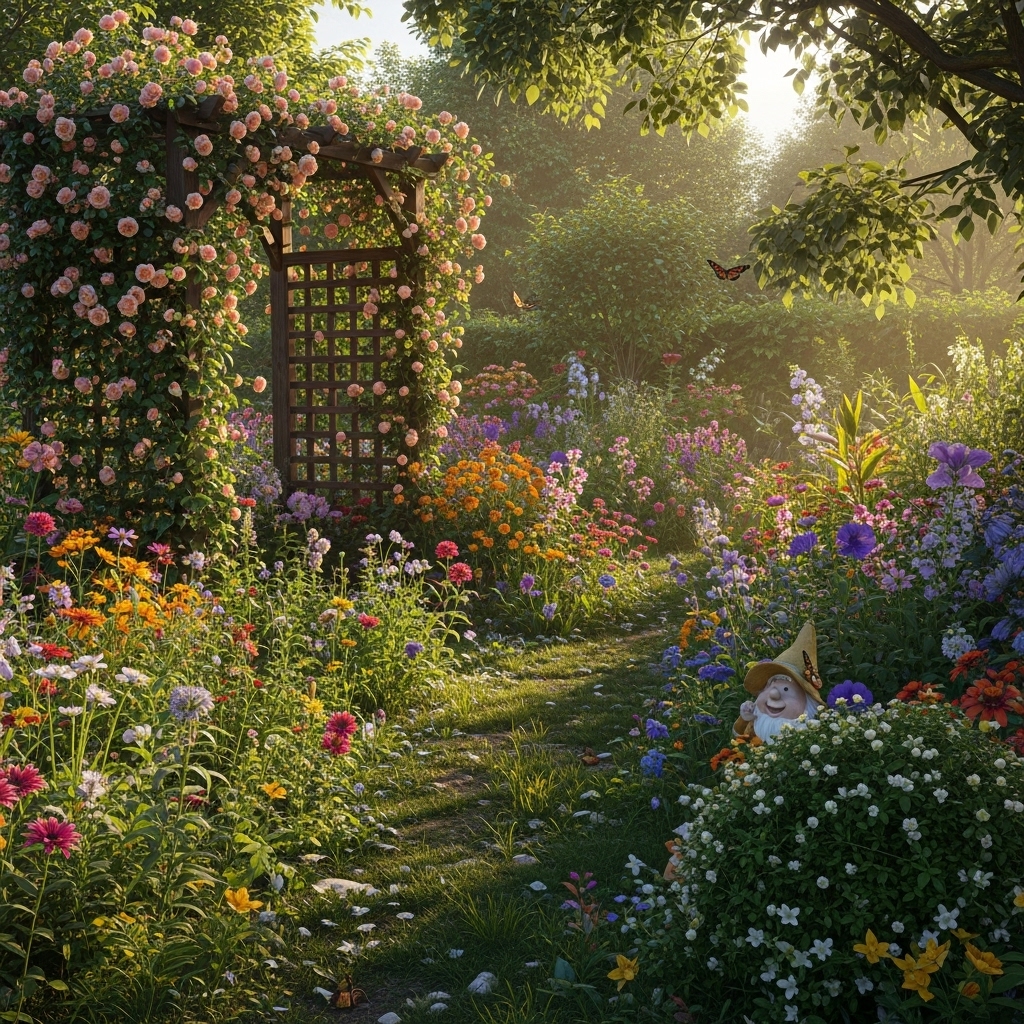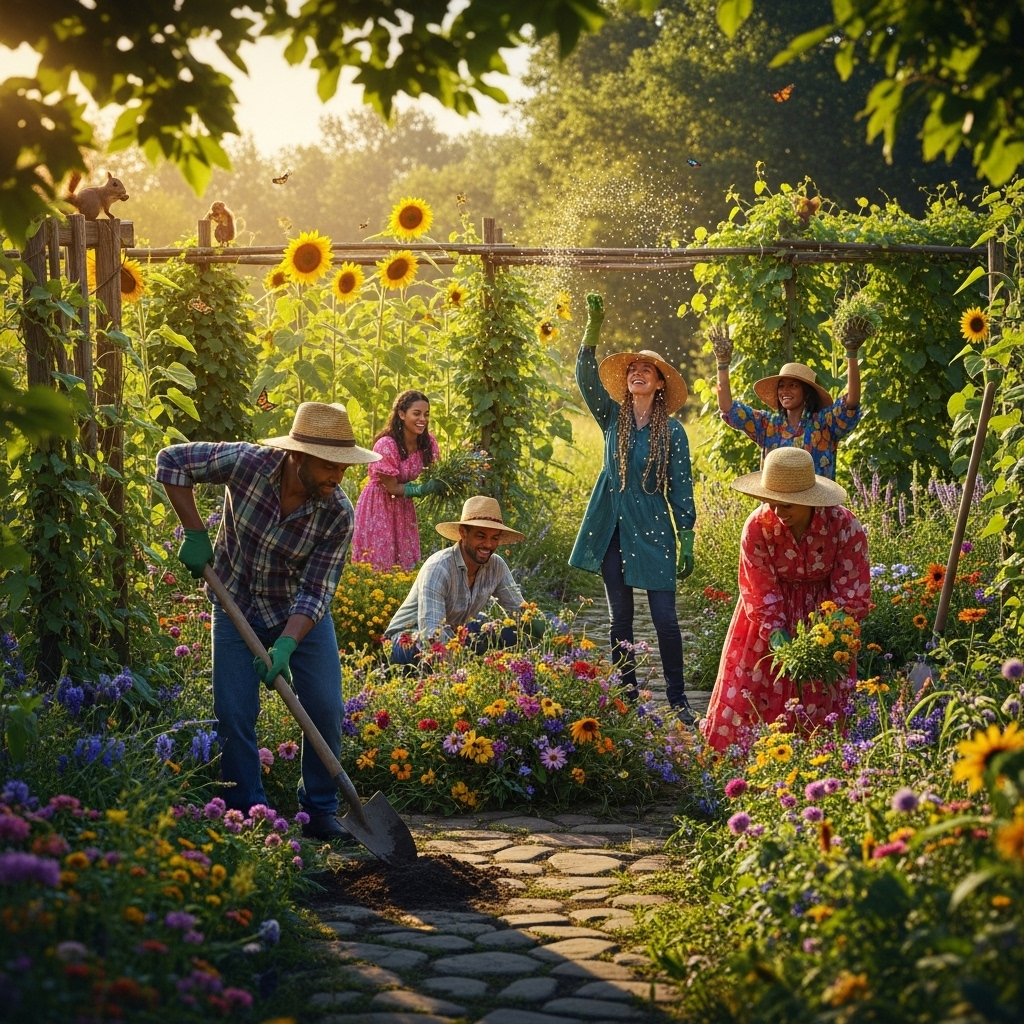There’s something magical about embracing the untamed beauty of nature in our gardens. In this journey into chaos gardening, I’ll share how to cultivate a wild yet harmonious space that bursts with life and color.
Understanding Chaos Gardening

When I first stumbled upon the concept of chaos gardening, I was captivated by the idea of stepping away from the rigid structures and manicured lawns that often dominate traditional gardening. Instead, chaos gardening invites us to embrace unpredictability, allowing nature to take the reins and create a beautiful, thriving ecosystem. It’s a philosophy that encourages a hands-off approach, where we become observers and caretakers rather than strict organizers. This method resonates deeply with my appreciation for nature’s inherent beauty and its ability to thrive without human intervention.
At its core, chaos gardening is about encouraging biodiversity and creating a space that is both aesthetically pleasing and ecologically beneficial. This approach aligns with the principles of permaculture, which emphasizes sustainability and self-sufficiency. I’ve found that when I let go of my desire for perfection, I can foster a garden that not only looks stunning but also supports a variety of wildlife, from pollinators to birds. It’s an exhilarating journey that begins with a few simple principles.
Embracing Diversity
The first step in chaos gardening is embracing the diversity of plants. I’ve learned that including a wide range of species, both native and non-native, can create a flourishing ecosystem. Native plants are especially valuable, as they are adapted to the local climate and soil, requiring less maintenance and providing essential habitat and food for local wildlife. I’ve found that plants such as coneflowers, black-eyed Susans, and milkweed not only add vibrant colors to my garden but also attract butterflies and bees, enriching the biodiversity of the area.
In addition to native plants, I’ve also experimented with companion planting, which involves pairing plants that benefit each other. For instance, planting marigolds alongside vegetables can deter pests and improve growth. This method has not only increased my garden’s productivity but has also added layers of texture and color that make my garden feel more alive. I love wandering through my garden and discovering unexpected combinations of plants that thrive together, creating a visually stunning and harmonious landscape.
Letting Nature Lead
One of the most liberating aspects of chaos gardening is the opportunity to let nature take the lead. Instead of meticulously planning every inch of my garden, I’ve learned to observe the natural tendencies of plants and the soil. I remember the first time I allowed a wildflower to bloom in my garden. Initially, I was hesitant, fearing it would disrupt my carefully curated aesthetic. However, I soon realized that its vibrant blooms added an unexpected charm and texture to the landscape.
This philosophy of letting nature guide my gardening choices extends to allowing plants to self-seed and spread. By avoiding the urge to remove every weed or unruly plant, I create an environment where life can flourish. I’ve seen firsthand how self-seeding plants can fill in gaps and provide continuous blooms throughout the seasons. It’s a beautiful way to witness the natural cycle of growth and decay, teaching me patience and appreciation for the changing seasons.
Creating Habitats
In my journey with chaos gardening, I’ve also learned the importance of creating habitats for wildlife. I’ve found that adding elements such as birdhouses, bee hotels, and even small ponds can attract a diverse array of creatures to my garden. These additions not only enhance the overall beauty of the space but also contribute to a thriving ecosystem. I love sitting in my garden, listening to the songs of the birds and watching bees flit between flowers, knowing that I’ve created a sanctuary for them.
Additionally, leaving some areas of my garden a bit wild and unkempt has proven beneficial. Piles of leaves or logs can serve as shelter for small mammals and insects, further enriching the biodiversity in my garden. This approach teaches me about the interconnectedness of all living things and reminds me that every creature has a role to play in the ecosystem.
Seasonal Changes and Adaptability
Another exciting aspect of chaos gardening is the way it encourages adaptability. Each season brings a new set of challenges and opportunities. I’ve learned to embrace the changes that come with each season, adjusting my gardening practices accordingly. For example, in the spring, I focus on planting and nurturing new growth, while in the summer, I enjoy watching my garden flourish. Autumn, with its vibrant colors and the shedding of leaves, reminds me to prepare for the dormancy of winter.
During winter, I’ve discovered that even in the quiet months, my garden holds beauty and interest. The textures of dried seed heads and the stark silhouettes of bare branches create a different kind of aesthetic that is equally captivating. It’s a wonderful reminder that chaos gardening is not just about the chaos of growth, but also about the beauty of rest and renewal.
As I continue to explore chaos gardening, I find myself more connected to the natural world and more in tune with the rhythms of the seasons. This journey has transformed my garden into a vibrant, living tapestry that reflects the wild beauty of nature, and I can’t wait to share more about the practical steps I’ve taken to cultivate this enchanting space.
Practical Steps for Chaos Gardening

As I delve deeper into chaos gardening, I’ve discovered practical steps that anyone can implement to create their own wild sanctuary. The beauty of this approach lies not in strict guidelines but in the freedom to experiment. I’ve learned that even small changes can make a significant impact on the overall health and vibrancy of my garden.
Soil Health
One of the foundational elements of chaos gardening is healthy soil. I’ve come to understand that the soil is the lifeblood of my garden, so nurturing it has been a priority. I’ve started using organic compost to enrich the soil, creating a nutrient-rich environment that supports diverse plant life. Each spring, I gather kitchen scraps and yard waste to create a compost pile that not only reduces waste but also contributes to the health of my garden.
Additionally, I’ve embraced the practice of mulching. Using natural mulches like wood chips or straw helps retain moisture, suppress weeds, and gradually enrich the soil as they decompose. I find it incredibly satisfying to know that I’m feeding the earth while also creating a more resilient garden ecosystem.
Water Management
Watering is another aspect that I’ve learned to approach with a more relaxed attitude. Rather than adhering to a strict schedule, I’ve started observing the weather and the needs of my plants. I’ve installed a rain barrel to collect rainwater, which not only conserves resources but also provides my plants with natural, chemical-free water. This practice has taught me to be more in tune with the natural water cycles in my garden.
I also appreciate the beauty of water features. By incorporating a small fountain or pond, I’ve created not only a stunning focal point but also a habitat for frogs and other wildlife. The sound of flowing water adds a tranquil ambiance, inviting me to spend more time in my garden and fostering a connection with the life it sustains.
Planting Techniques
When it comes to planting, I’ve learned to embrace a more intuitive approach. Instead of following rigid spacing guidelines, I often cluster plants in groups, allowing them to interact and support each other. I’ve discovered that this method encourages a more natural look, where plants can weave in and out of each other, creating a tapestry of color and texture.
Moreover, I’ve found joy in seed bombing—creating small balls of seeds, clay, and compost that I can toss into bare spots or areas where I want to introduce new life. This spontaneous method has led to delightful surprises, with unexpected blooms popping up in places I never anticipated. It’s a simple act that fosters a sense of adventure in my gardening journey.
Wild Foraging
Another exciting dimension of chaos gardening is wild foraging. As I’ve embraced the untamed aspects of my garden, I’ve also begun to appreciate the wild edibles that grow around me. I’ve learned to identify and harvest plants like dandelions and purslane, which are not only nutritious but also delicious additions to my meals. This practice connects me further with my environment and teaches me to value the abundance that nature provides.
Foraging has transformed my perception of weeds. Instead of viewing them as nuisances to be eradicated, I’ve come to see them as potential allies. Each time I discover a new edible plant, I feel a rush of excitement and gratitude for the gifts my garden has to offer.
Documenting the Journey
Finally, I’ve found that documenting my chaos gardening journey has added another layer of joy to the experience. I’ve taken to keeping a garden journal, where I record my observations, successes, and challenges. This practice not only enhances my appreciation for the growth process but also allows me to reflect on the changes in my garden throughout the seasons.
Photography has also become a meaningful part of documenting my journey. Capturing the beauty of my garden in various stages reminds me of the fleeting nature of blooms and the importance of cherishing each moment. Each photograph serves as a testament to the wild, wonderful transformations that take place in my space.
As I continue to embrace chaos gardening, I’m constantly reminded that this journey is not just about cultivating a beautiful garden but also about cultivating a deeper relationship with the natural world. The more I explore these practical steps, the more I realize that chaos gardening is a journey of discovery, creativity, and connection that enriches my life in profound ways.
Final Thoughts
Chaos gardening has opened up a world of possibilities for me, allowing me to connect more intimately with nature and embrace the untamed beauty that surrounds us. Each step I take in this journey enhances my appreciation for the intricate web of life within my garden. As I continue to nurture this wild sanctuary, I look forward to sharing more insights and experiences that celebrate the vibrant chaos of gardening.
